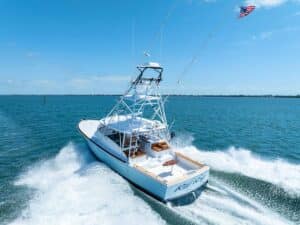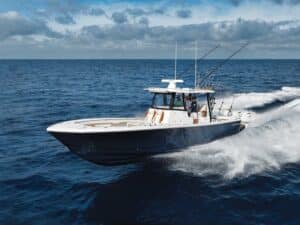
That tropical invest you’ve been watching for the past week has just been named, and the damn thing is heading right toward you. Like most storms, it will probably turn away, but due diligence always pays in situations like these.
The first priority is to get out the storm gear and inspect it thoroughly. Inventory everything so you know what you have and what needs to be purchased. Check each line for chafe or an unraveling splice, and inspect the chain links and shackles. And whatever you do, don’t wait until the last minute, especially if you have to move—or haul out—the boat.
Windage, Water Intrusion
Before you put on even one extra rope, you must reduce the windage. Windage refers to anything that might blow away, up or off, and cause damage: covers, enclosures, outriggers, antennas, helm chairs, rocket launcher/fighting chair, etc. Remove and safely store anything that can blow off the boat.
Some items, such as chair pedestals, can be left in place; just cover the open flange with two plastic zipper bags and secure them to the pedestal with electrical tape. Electrical tape stretches, sticks to itself, and will stay put in a moderate storm, as long as you stretch the tape tight on the bag and not the pedestal itself.
Watch: Take an immersive look at Quepos and the Offshore World Championship.
After addressing the windage, set your storm anchors. Start by setting your boat’s day anchor first, then the storm anchor, making sure the anchors are set in a “V” pattern—with the bottom of the V being your boat—to absorb pressure from two or more wind directions. Always cleat off the anchor rodes; never let them sit on the windlass drum. Use chafing gear where necessary, especially if you have a pulpit or fairlead. Once you are set, mark your anchor lines with two small buoys so that other boats don’t run over them and you can find your anchor should the rode separate during the storm. Set your anchors last if you are on a busy waterway so you aren’t blocking areas of navigation.
Next, tape down everything that could possibly fly open: cabinet doors, bench seats, console lids, electronics covers, teaser-reel boxes, tackle centers, etc. I have found that on gelcoat, white shrink-wrap tape works best, but it will not stick to teak, so I don’t bother with the cockpit deck hatches, but I do tape the gaps in the engine-room hatch to avoid water intrusion. Make sure all of the other hatches are locked: Bomar hatches, anchor locker, transom door and any other door that might fly open.

Weave the Web
Remove all the fancy dock lines, and replace them with three-strand nylon ropes. These stretch nicely for good shock absorption and will keep your boat from snapping around in the slip, reducing stress on the cleats, dock, or pilings you are tied to. Think about the wind directions likely to occur, and start off with one line per cleat to account for each wind direction in relation to your slip. The goal is to distribute the energy so that one line, or one cleat, is not taking the brunt of the force. When completed, your boat should look like it’s being held in place by a spider’s web.
I use the rope’s loops on the boat’s cleats and the bitter ends on the dock, unless I double-back the ends. This leaves optimal room for extra lines, and because it is dangerous to board a bucking boat in 74-plus mph winds, it’s much safer to adjust during the storm (not recommended) from the dock. I also stash a small hatchet in case I need to cut any lines in an emergency.
Next, set the fenders. I use a minimum of six fenders for my 50-foot Viking. Large, round poly balls work well between neighboring boats or against seawalls. Rough water and moving floating docks could easily allow the fenders to jump up and onto the dock if tied to the boat, which would then offer no protection to your hull. Tying your fenders to the dock will also free up much-needed cleat space; always keep your fenders off your engine-room vents to avoid damage, and never tie anything to tower legs or rod holders because aluminum bends easily under stress.
Any rope through a hawse pipe, laid on a chock, tight on an edge, or rubbing another rope needs chafing gear. Reinforced polyester hose that is slightly larger than the diameter of the rope works well, and the hose can be sewn or zip-tied in place to prevent slipping from its intended position.
It is likely that you will tie, untie, move, and adjust the storm lines a few times before you are satisfied with their positioning. Check the lines as the tide rises and falls: Is one pulling too hard? Is one rope coming tight before the other when tied off to the same cleat? Are two lines rubbing against one another? Depending on your area and the storm path, the water level and currents will fluctuate immensely, so don’t make the ropes too tight—or too loose. While you’re waiting on the tide, always offer to help a neighbor, especially if you see anything on their vessel that could damage yours. You can do all you can, but if your neighbor falls short, you are likely to pay the price. In this business, we help each other; it’s part of the bluewater brotherhood of which we are so proud to belong.

Final Prep
After the boat is tied up to your satisfaction, turn off any breakers that are not needed, especially those for equipment that could be damaged by a power surge or lightning strike, as well as anything that might drain the batteries during an extended power outage. You can turn off the DC side of the panel; just ensure that all bilge pumps are hard-wired so they’re not affected. It’s important to know that if your batteries go completely dead, the fire-suppression system might not work because it usually runs off your ship’s service battery bank. Also consider unplugging your boat. That power pedestal could become dangerous should the dock’s electrical box break loose and live wires be exposed to water. I close all through-hulls, except the generator’s, which I like to run to keep the batteries sufficiently charged for as long as possible.
Read Next: Get to know some of the photographers who have contributed to the unique look of Marlin over the years.
The last thing you’ll want do is take pictures. An insurance underwriter will undoubtedly ask for proof of adequate storm prep should you need to file a claim; consult the insurance policy before the storm to make sure you’ve met all of the requirements for coverage.
On the way off the boat, lock the salon door and say a little prayer. Hurricane preparation is stressful but manageable. Prepare the boat early, and leave yourself enough time for final adjustments as the storm path changes, and remember: Personal safety always comes first.







